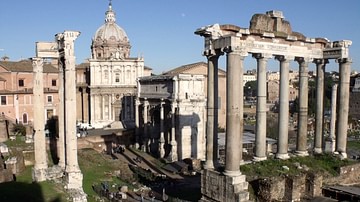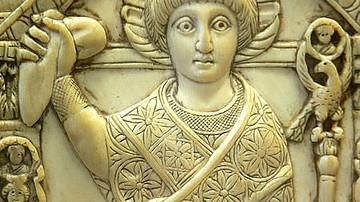
Roman constitution was an accumulation of laws, legal decisions, and ancient customs. While today 'constitution' usually refers to a single act of legislation, this was not the case in ancient Rome. Instead, Roman government relied on the wisdom and customs of their ancestors as Roman law developed gradually over time.
From Monarchy to Republic
The Roman Republic began with the expulsion of the last king, Lucius Tarquinius Superbus (r. 534-510 BCE). In his The Early History of Rome, Livy (59 BCE to 17 CE) wrote:
Tarquin the Proud reigned for twenty-five years. The whole period of monarchial government, from the founding of Rome to liberation was 244 years. After the liberation, two consuls were elected by popular vote … the vote was by centuries according to the classification of Servius Tullius. (104)
To prevent a return to a monarchy, a republic was instituted; the rule by one was replaced with rule by the elite, the patricians. Simon Baker in his Ancient Rome wrote that the overthrow of the Etruscan kings "would become the most pivotal point in early Roman history" (32). However, the Roman Republic "was a system of government that evolved slowly over a long period of time and was subject to continual tweaks and improvements" (ibid). The Republic did not come into existence overnight but suffered both internal and external conflicts: "The Republic was a stable, conservative, yet adaptable form of government that provided the platform for Rome's rise to the greatness" (Gwynn, 24).
Central to this ability to adapt was its division of power. All policy decisions were dependent on the collaboration of the voting assemblies, the magistrates, and the Roman Senate. Whether written or not, it was this interaction that allowed the Roman constitution to work. Although tradition and legal documents were essential, the foundation of any constitution was its laws.
Roman civil law was based on four sources:
- custom
- the Twelve Tables
- writs
- legislation from the various assemblies
Assemblies
In Rome, there were four voting assemblies:
- comitia curiata – responsible for the appointment of magistrates and priests and the confirmation of wills and adoptions
- comitia centuriata – responsible for the election of magistrates, enacting laws, and making decisions regarding Roman warfare
- the comitia tributa – responsible for minor trials, enacting laws, and lower-level elections
- concilium plebis – responsible for enacting laws and representing the interests of the plebeians
Although most of its original duties were gradually absorbed by the comitia centuriata, the comitia curiata – which dated from the days of the kings – still witnessed the appointments of magistrates and priests (lex curiata de imperio) as well as confirming adoptions and wills. It was presided over by the pontifex maximus, a consul, or praetor. Next, aside from enacting laws, the comitia centuriata elected senior magistrates such as consuls, praetors, and censors, as well as declared war and peace. In 200 BCE, and for the only time in Roman history, the assembly refused a consul's request to declare war against an enemy (Carthage) – it was, of course, persuaded to change its vote. The comitia centuriata also invoked the death penalty on Romans who were arraigned on political charges. The assembly met outside the sacred boundary of the city (the pomerium) on the Campus Martius or Field of Mars.
The third Roman assembly was the comitia tributa or tribal assembly. Tribal assemblies consisted of both patricians and plebeians and were divided into 35 tribes (4 urban and 31 rural), based on one's ancestors. Each voted separately and then came together; the majority won and a decision was made. The assembly enacted laws, oversaw minor trials, and elected quaestors, aediles, and military tribunes.
As its name implies, the concilium plebis, or Assembly of the Plebs, represented the interests of the plebeians. From the Republic's early days, the government was in the hands of the patricians. The plebeians objected, demanding an equal voice; a struggle emerged, commonly called the Conflict of Orders. In 494 BCE, the plebeians went on strike, walking out of the city en masse to Janiculum Hill across from the Tiber. In the wake of the Secession of the Plebs, the patricians were forced to make concessions, and a compromise was reached: the concilium plebis, presided over by a tribune, was established. Livy wrote:
Negotiations began and an agreement was reached on the condition that special magistrates should be appointed to represent the commons; these officers – tribunes of the people – should be above the law, and their function should be to protect the commons against the consuls. (147)
Initially, the assembly enacted laws or plebiscites that applied only to the plebeians; however, the lex Hortensia of 287 BCE declared a plebiscite binding to the entire population. When the tribune Tiberius Gracchus (163-133 BCE) wanted his land reform proposal (lex agraria) enacted and feared that his proposal would be blocked, he appealed directly to the concilium plebis, ignoring the law and bypassing the Senate; the proposal was passed.
Twelve Tables
Roman laws were not published; instead, they were kept in the care of the pontifices and contained in sacred books. In 462 BCE, a tribune demanded that the laws governing the duties of a consul be published; this demand would be extended to all laws. Livy wrote of the tribune's accusations:
Consul, he declared might be less hateful word than King, but in actual fact consular government was even more oppressive than monarchy, in that the country has taken two masters in place of one. (23)
In 451 BCE, the disagreement led to the suppression of the constitution and the abolition of the positions of both the consul and tribune. A Board of Ten (decemviri legibus scribundis) was placed in control of the state and given the duties to review and codify the laws. Livy wrote:
Thus it happened that 302 years after the foundation of Rome the form of government was for the second time changed, once power had passed from kings to consuls, now it passed from consuls to decemvirs. (253)

Over a two-year period, the decemviri created twelve laws which became The Table of Twelve; it was the first recorded Roman laws. The twelve dealt with various aspects of Roman life: domestic issues, private property, inheritance, debt, and even the emancipation of slaves. One controversial law, later repealed, prohibited a marriage between a patrician and a plebeian. Livy claimed:
A meeting of the comitia centuriata – or Assembly of the centuries – was held and the Laws of the Ten Tables were adopted, which still today remain the fountainhead of public and private law… (235)
After the decemviri were expelled and the constitution restored, including the positions of consul and tribune, the newly elected consuls initiated three new laws: the sacrosanctity of the tribunes was endorsed, the right of a citizen to appeal was confirmed, and the proposals of the concilium plebis was given the force of law.
Magistrates
Of course, without the voting assemblies, there would be no Roman constitution; however, essential to the functioning of the assemblies were the magistrates. The assemblies enacted the laws while the magistrates administered them. And, like the voting assemblies, the duties of the various magistrates evolved over time. The road to becoming a magistrate was through the cursus honorum. Eash step brought one closer to the ultimate goal: a consulship. There were four steps on the cursus honorum:
Usually entering the office at the age of 30 after serving as a military tribune, the quaestor was elected by the comitia tributa and usually served one to two years. The tribune Gaius Gracchus (154-121 BCE) took exception to this when he served as a quaestor in Sardinia. After being extended to a third year, he protested and returned to Rome where was charged with dereliction of duty (he beat the charges). Although changes occurred over time, a quaestor's primary function was that of a financial officer. However, while serving under the direction of a provincial magistrate, he was expected to perform the duties of the magistrate in his absence. Unlike the consul and praetor, he did not have imperium power; however, thanks to Sulla (138-78 BCE), he automatically became a member of the Senate upon his election.
Elected by the concilium plebis at the age of at least 36, the aedile was the next step on the cursus honorum. Like the quaestor, he did not have imperium power. Serving only for one year, his duties were extensive: everything from caring for the streets to supervising the games. More specifically the aedile duties included the cura urbis – caring for the fabric of the city: its streets, water supply, public works, and markets – the cura annonae – managing the corn supply – and lastly, cura ludorum sollemnium – supervising the repairing and cleaning of the roads, streets, and public Roman baths.
Next on the cursus honorum was the praetor, elected by the comitia centuriata at the age of at least 39. Like the consul, he had imperium powers. Although he could perform many of the duties of a consul, such as preside over the Senate and command the army, his primary duties included that of a legal officer.
The ultimate goal of anyone on the cursus honorum was to become a consul. Unlike others on the path whose numbers often changed, there were always only two consuls elected by the comitia centuriata. A consul served a one-year non-consecutive term – occasionally someone did serve more than one term. Livy wrote:
… the first step towards political liberty in Rome consisted in the fact that the consuls wee annually elected magistrates – in the limitation – that is, not of their powers but of their period of office. (108)
The consul had imperium power, both political and military. He commanded the army, presided over the Senate, and could propose legislation; each consul could veto the actions of the other (intercessio). Some consuls could extend their sense of duty by becoming a proconsul, governing one of the provinces. Initially restricted to only patricians, plebeians became eligible in 367 BCE, and by 342 BCE, legislation dictated that one of the two consuls had to be a plebeian. As a symbol of their authority, they wore a traditional woolen toga with a purple border and were attended by at least six special assistants or lictors. Their symbol was the fasces, the bundle of rods with an axe. At the end of their one-year term, they were held accountable for any decisions made or actions taken.
Since all the positions were unpaid, an individual had to have an independent means of financial support to climb the ladder. There were also three magistrates outside the path:
- censor
- dictator
- tribune
Usually an ex-consul, the censor did not have imperium powers but still held considerable influence and authority. He was elected by the comitia centuriata and served for 18 months. His duties included: maintaining the official list of Roman citizens, supervising the morals of the community (regimen morum), and leasing revenue-producing public property. A senator, convicted of immoral behavior, could be dismissed.
Finally, the dictator was an emergency position and served only for the duration of the crisis. Julius Caesar (100-44 BCE) was named dictator four times, the last time for life.
The final magistrate outside the cursus honorum was the tribune of the plebs (tribunus plebis). Ten tribunes were elected every year by the concilium plebis. Initially, a tribune's duties consisted of protecting the rights of the plebeians from the abuses of the patricians. Over time his duties allowed him to convene the Senate and proposed legislation in the concilium. With the power of intercessio, he could veto the actions of any other magistrate. His powers were sacrosanct owing to an oath taken by the plebeians – the lex sacrata – which bound an individual to defend the tribune to the death. With the authority given to him, he could fine, imprison, or execute anyone who challenged his authority. However, to counter a possible autocratic decision, an appeal could be made.
The Senate
The last essential element of the Roman constitution was the Roman Senate. Even though they had limited constitutional powers and did not pass laws, the Senate was "the key institution in the making of policy decisions" (Companion, 269). The primary role of the Senate in the creation of a constitution was through its influence and the respect that it commanded. The Senate discussed military policy, the conduct of war, and the issues of foreign policy. They also discussed financial matters and issues of law and order. According to Gwynn, the magistrate summoned the assemblies and "only brought before them issues that had been debated already by the Senate, and the assembles almost invariably endorsed the Senate's decision" (24). He concluded that "The Republic was governed by the Senate and People of Rome very much in that order" (ibid). On the standards of the Roman army were the letters SPQR – Senatus Populusque Romanus – the Senate and the Roman People.










